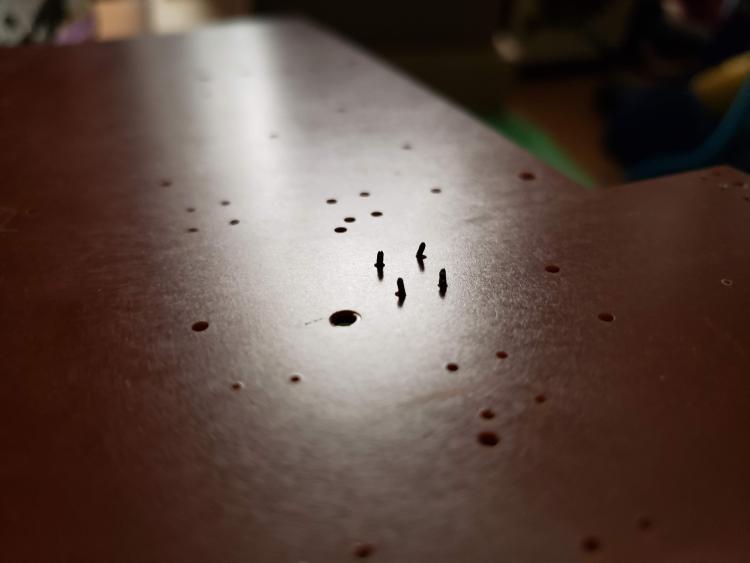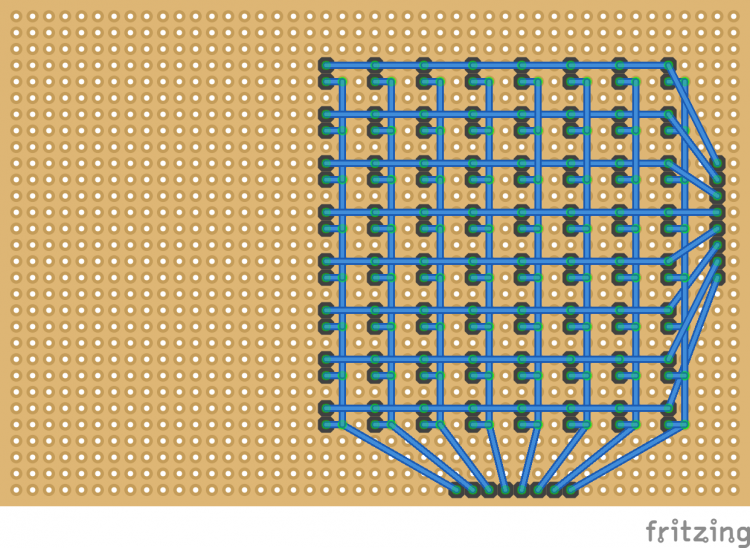-
Posts
55 -
Joined
-
Last visited
-
Days Won
1
fallenturtle last won the day on February 8 2016
fallenturtle had the most liked content!
About fallenturtle
- Birthday 08/10/1977
Contact Methods
-
Website URL
http://fallenturtle.com
Profile Information
-
Gender
Male
-
Location
San Francisco
Recent Profile Visitors
The recent visitors block is disabled and is not being shown to other users.
fallenturtle's Achievements

MIDIbox Newbie (1/4)
1
Reputation
-
MDF board to mount control suface compontents... bad idea?
fallenturtle replied to fallenturtle's topic in Design Concepts
I think my accuracy issues might be more related to the drill press itself. There's definitely some play with the arm that moves the drill down and maybe there's a way I can tighten it, I'll have to look, but probably not, its pretty cheap. I assume the slide won't help with that? -
MDF board to mount control suface compontents... bad idea?
fallenturtle replied to fallenturtle's topic in Design Concepts
I thought about it, but I do think the spacing and size requirements might make that hard. Is there a such thing as a perfboard without the metal bits? -
MDF board to mount control suface compontents... bad idea?
fallenturtle replied to fallenturtle's topic in Design Concepts
I'm actually building this inside of a VIC-20 case. I didn't always plan to be anachronistic, and was going to put this inside a C64C case, but there wasn't enough room for the keyboard and the mb-6582. If money wasn't a problem, I'd create a custom PCB, but alas. -
MDF board to mount control suface compontents... bad idea?
fallenturtle replied to fallenturtle's topic in Design Concepts
I'm lousy at drawing, but i took some photos to illustrate what I'm doing. The knobs I got wedge perfectly into the cavities for the keyboard switches on the frame. Those leads will attached to wires between the PCB and the frame and come out a hole somewhere. The switches mount into the board using holes I've drilled. In one of the attached pics you can see the leads sticking through. My skills using a Drimel drill press have proved less than ideal when it came top lining up the spinning bit with the mark for the hole and so some of the drilled holes have been off by a few mm. I feel bad wasting this keyboard PCB and in hindsight I would have gone straight to creating a board like I'm going to do now (I was less "woke" to retro computer preservation than I am now). -
My MIDIbox SID project is using a C64/VIC-20 keyboard as its control surface. The encoders and switches were to be mounted to the PCB that attaches to the keyboard frame (with wires directly attached the the component leads instead of using the PCB's own traces) but I've decided that's a bad idea since I'll have to go through extra steps to make sure none of the preexisting traces on the board short anything. My new plan is to get some board like material similar in density and thickness to the original keyboard PCB, cut it to size, and use it instead. I was thinking of MDF because it seems it can match the requirements of being thin yet sturdy, but I wasn't sure if this was a bad idea, like if there might be moisture in MDF that could cause shorts. So I thought I'd ask you folks who are more seasoned when it comes to materials and electricity. Would MDF be a bad idea and if so, what would be a good alternative?
-
My MIDIBOX SID build is using the MB-6582 main board and a custom control surface. I'm building it inside a VIC-20 case and the control surface is built on a modified keyboard using the keys as buttons. The encoders I got push up through the holes in the keyboard tray. Due to a lack of room I'm not including the matrix. LEDs are placed around the keyboard area and my attached layout shows where I'm thinking of putting them. I went through a bunch of different layout ideas and ultimately went with whats attached. I tried to keep knobs near the edges so i can put labels right next to them. My goal is to have the chosen keycaps represent the button functions, but I'm limited by the fact that I only have a single keycap set. I'm using the old PET style keys so its hard to get extras without paying an arm and leg. Hence I'd love to have two CTRL keys, but I only have one so I'm using A for Osc knobs ENV/MISC/ASSIGN selector. While I think I tried to place everything as optimally as possible, I lack the experience of using these devices so I thought I'd see if any of you seasoned MIDIBOXers might have any thoughts, suggestions, or see any obvious pitfalls I might be missing with what I choose to do. For anyone interested, I'm documenting my progress on a blog on my website: http://www.fallenturtle.com/c64blog Thanks!
-
- control surface
- mb-6582
-
(and 1 more)
Tagged with:
-
Has anyone try using dry transfer (letraset) letters onto a surface like the Commodore 64/VIC case?
- 3 replies
-
- control surface
- decal
-
(and 1 more)
Tagged with:
-
I already own a ptouch and with clear tape even, but I think it will have the same issue of looking like a sticker. The laser etch transparent panel might be interesting, depending on its height. Thanks for the link. I didn't realize until I did more research that they make rub offs that can be printed in a laser print, so I'm also considering that since ultimately what I'd like is to have the lettering directly on the case surface and with no shiny transparent margin around them which I think is what I might get with the water transfer technique.
- 3 replies
-
- control surface
- decal
-
(and 1 more)
Tagged with:
-
I'm building my synth inside a Commodore VIC-20 case. The LEDs will be poking out of the surface so I'm trying to figure out the best way to apply labels to the case surface. One method I'm considering is using water slide decals which are popular with people who do models and custom guitar gear. The pack of this special paper is $20 so I'm hesitant to buy some if its going fall off or look like crap. Has anyone had any experience trying to use these type of decals on a surface like the commodore cases? My concerns are: 1) while the case is mostly flat, its got a little texture, so I'm wondering if that will lead to the decals falling off. 2) If the case is matte and I'm not planning to apply a clear coat to the top, will the edges of the decals be really obvious and look bad? I'm also open to suggestions on better ways to apply the labels.
- 3 replies
-
- control surface
- decal
-
(and 1 more)
Tagged with:
-
-
I'm still working out how I'm arranging the front panel. It's based on a C64* keyboard with the encoders and switches being on the keyboard grid and the LEDs around it coming out of the C64* case surface. See image. Because of this I think none of possible arrangements will work for or against direct wiring vs matrix wiring. I think I'd rather deal with wiring 2 matrices then buy more DIN and DOUT boards and they required components for them (though I do have one DIN module completed from my since abandoned modular MIDIBox SID. *Actually its a VIC-20 keyboard and case, but I'm pretending is from a C64.
-
Those are pin headers I'm using for going to the switches and the black horizontal things are the diodes.
-
I'll go ahead and add the sinks. I downloading Fritzing to try to mock up the matrix so to get a better visual idea of what I'm doing. Does this mock look like I get the idea? This is for the DIN matrix.
-
If I'm following you correctly it sounds like its easier to create matrix routing on a printed stripboard than direct wire each LED/switch. I was hoping I could just use the DIN and DOUTs that are on the MB-6582 base PCB. I didn't get the BC547s for T2-T9 because I didn't think I needed them if I'm not using the Mod Matrix, but if I AM using JD8, then does that mean I need them after all?
-
Okay, so I will need to buy some 1N4148 diodes? The official control surface PCB is some what of a maze for me... do I put a diode between each switch/LED and JD8?











